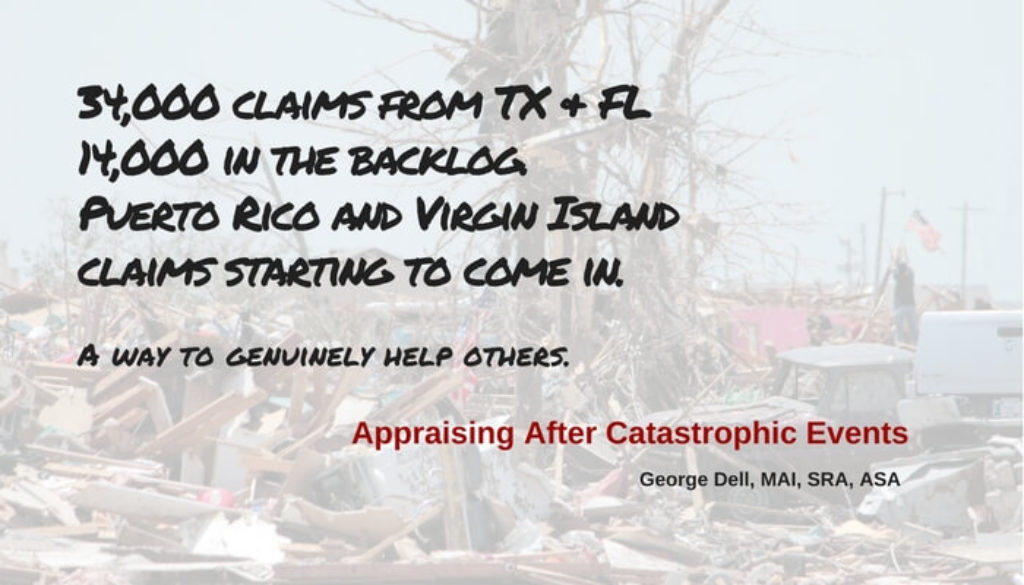{Author’s note: Thank you to the Houston Chapter of the Appraisal Institute for the opportunity to present this timely topic. Recovery after a major catastrophe is a marathon, not a sprint. We have been affected hurricanes, floods, and now, wild fires up and down the California coast. Appraisers can help. Please consider offering your time and expertise. }
Events happen.
Things change. Events present opportunities to help others . . .
We get so used to appraising under normal conditions, it is easy to forget the basic assumptions we must consider each and every assignment.
We have always emphasized the importance of price index models to establish exact time adjustments. In Stats, Graphs and Data Science2, we do a class exercise in which the students calculate the impact of catastrophic events with before and after trends. The distance between the two trend lines (usually linear), provides an exact value for the immediate impact of the event itself.
I will be teaching Stats, Graphs, and Data Science1 in Houston (Oct. 10-11), right after the ASA International Conference next week. We’ll include both trend analysis, and event impacts in this class. Hosted by the Houston Chapter of the Appraisal Institute, it’s part of their 28-hour recertification seminar, Oct. 9-12. Seats are available for the entire four-days or for the 14-hour, SGDS¹ segment and for the 7-hour classes. Follow the link to see all of the options available.
The trend prior to an event is usually easy to calculate, with very little model decisioning involved. After the event, there is usually an immediate shift, as well as a new trend to be established.
In preparing for the Houston class, it became obvious that other issues and assumptions of appraisal assignments must be considered. One of the best guides is the Appraisal Institute’s Guide Note 10, Development of an Opinion of Market Value in the Aftermath of a Disaster.
It is important to consider what we often take for granted – the very assumptions (required conditions) for “market value.” Even the definition of market value (which is actually market price) comes under stress. [We learned in the last economic meltdown that market price ≠ market value.]
Following the FIRREA definition,
I find seven conditions, as follows:
- Participants act prudently and knowledgeably;
- They are not affected by undue stimulus;
- Buyer and seller are typically motivated;
- They are well informed or well advised;
- With reasonable exposure time;
- Cash equivalent measure;
- Not affected by special or creative financing.
The only condition not usually affected after an event is the cash equivalent measure. All the others are usually affected by the event! All!
- Participants are often under atypical emotional and financial stress. Few have knowledge of disaster aftermath economics.
- Undue stimulus is prevalent. The need to have a place to live, to repair the damage, to move elsewhere, and financial/governmental influences (such as insurance, FEMA and the SBA).
- Motivations are all over the place.
- Brokers, agents, attorneys, even appraisers are seldom in a position to provide good informed advice.
- Marketing time will vary greatly from one seller to another. The resulting exposure time will be linked to other elements of this list, including actions of FEMA and others.
- Financing is commonly non-typical.
My friend Steve Smith is currently doing FEMA work. (Signed up for a 90 day contract). He is a cost estimator for the SBA disaster loan program.
As a story, he told of one victim, (with no flood insurance) who was offered a 1% reconstruction loan. The person said he would not be able to repay it anyway. This is a short story, but is an example and shows the importance of each story. Each story, each appraisal, each seller, each property is a separate story. Methinks it behooves us to look back to each of the seven elements of “market value” in each and every case. This look back can simplify the work, and make it fit the reality, not make-believe normal market stuff!
Steve says there have been 34,000 claims since the Texas storms, with 14,000 in the backlog. Puerto Rico and Virgin Island claims are just starting to come in.
They’re hiring appraisers and others.
There is great need.
A way to serve. A way to feel good about oneself. A way to genuinely help others.
Four personal rewards in one shot. Not a bad deal!
